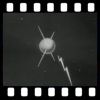Catching Telstar
Telstar was launched on July 10, 1962.
Not much more than a meter across, it was a remarkable contrast to the massive receiving apparatus to which it would speak. "Catching" the Telstar signals was not entirely straightforward. Unlike present-day satellites, which tend to be in geo-stationary orbit, hovering above a more or less fixed point above the Earth, Telstar circled the earth rapidly relative to the land. In a so-called elliptical orbit, Telstar flew high above the Pacific ocean and low over the Atlantic, circling about every 2.5 hours. This meant that there was a window of transatlantic transmission of about twenty minutes, during which time the ground stations on either side of the Atlantic would serve as links between the broader networks.
This required intense cooperation between the major commercial networks on the USA side, and links to the Eurovision network in Western Europe.
 Previous Story
Next Story
Previous Story
Next Story
How to cite this page
Alexander Badenoch, 'Catching Telstar', Inventing Europe, http://www.inventingeurope.eu/philips/catching-telstar
Sources
- Schwoch, James. Global TV: New Media and the Cold War, 1946-69. University of Illinois Press, 2008.





















